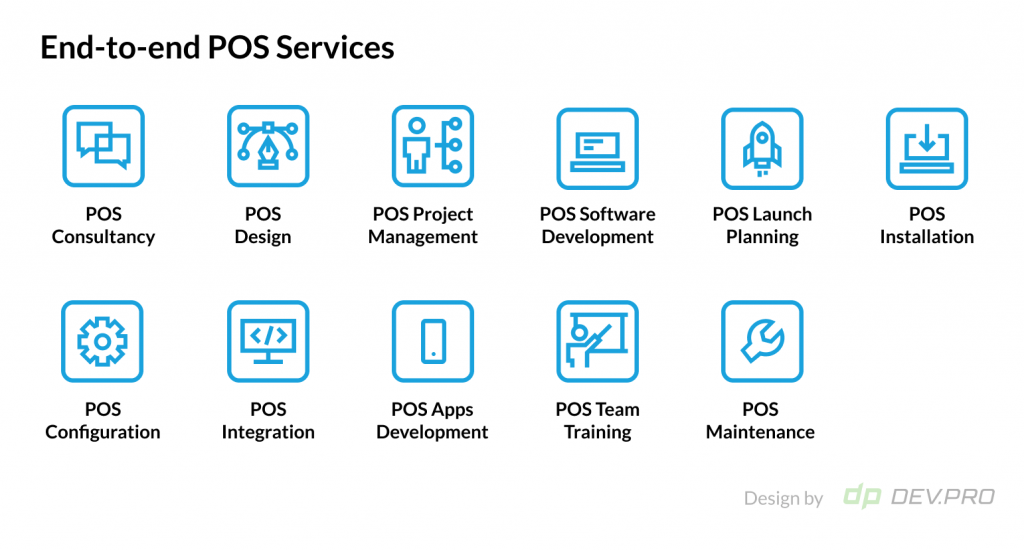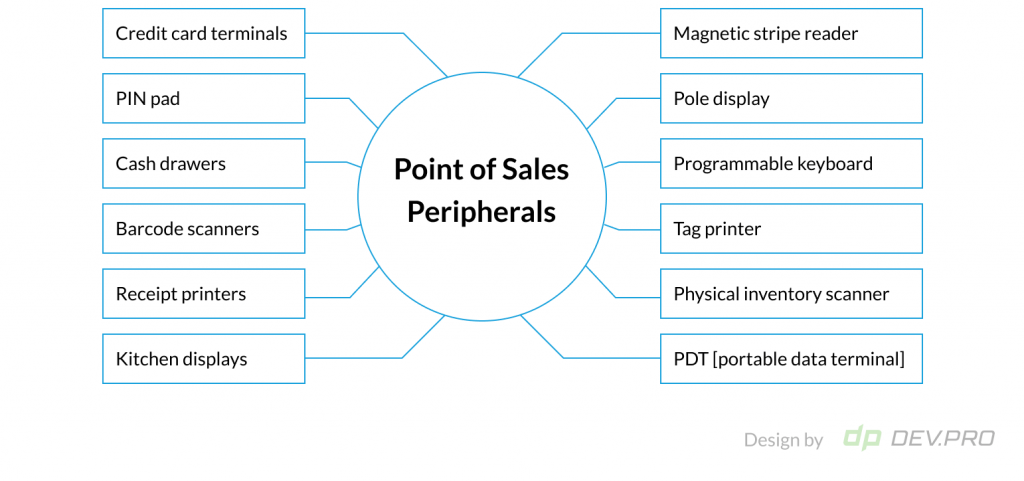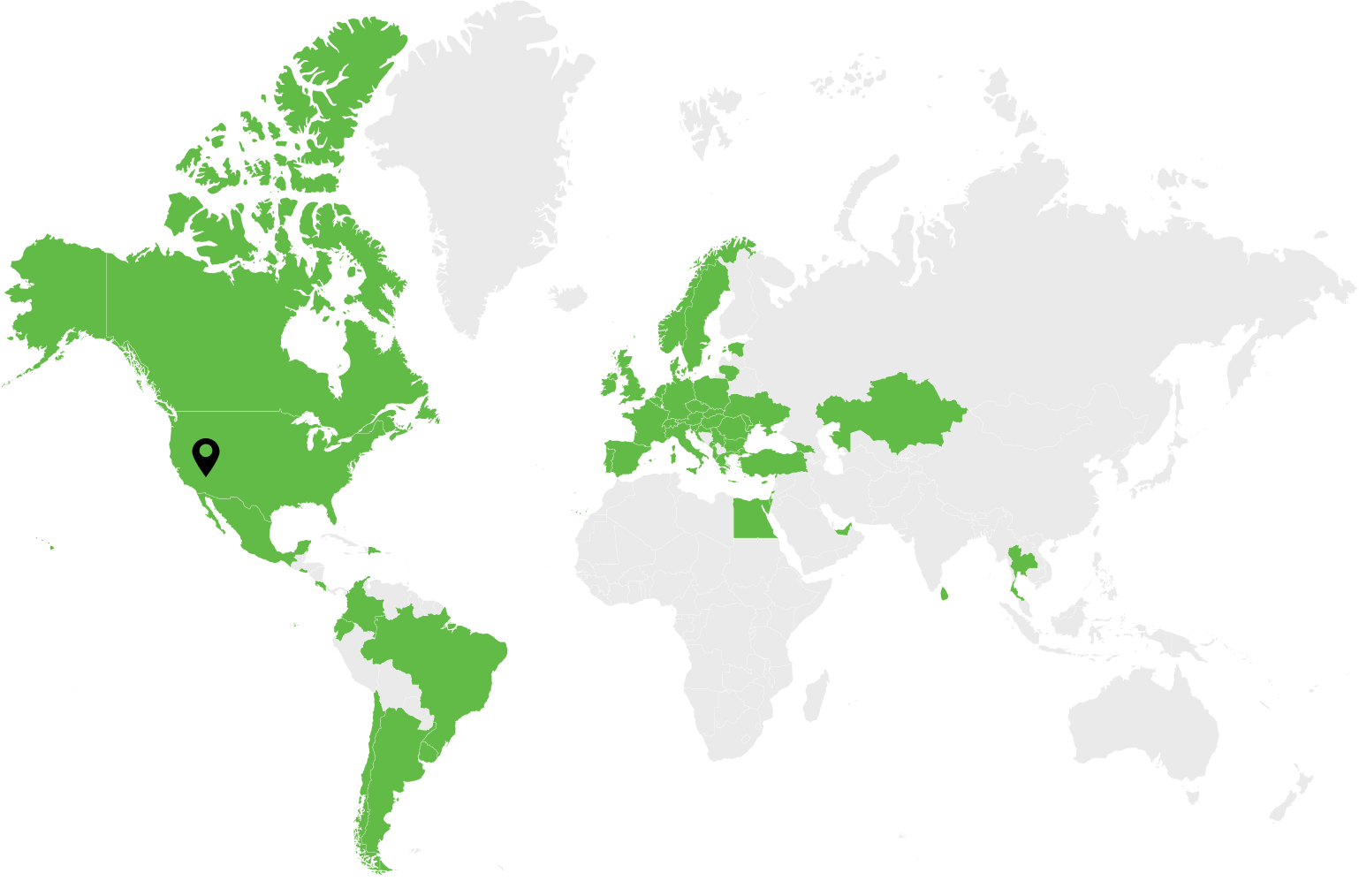Chain restaurants in the U.S. are a $125 billion market. That figure is expected to grow nearly 20% in 2021. As a result, there’s a growing need in the industry for POS software development, integration, and configuration services. However, Capterra’s long list of ready-made point of sale systems for restaurants may raise a question: why would you need and how to create your own POS software?
Here are a few reasons you may want to create a custom POS system:
- Provides your team with only necessary concept-specific features, [no cluttering screen with default unused ones]
- Seamless integrations with other proprietary custom restaurant management software solutions;
- An opportunity to experiment with analytics and new features to gain competitive advantage irrespective of vendor’s vision.
In this article we are going to answer a few debatable questions for restaurant chain business owners and franchise chain entrepreneurs:
- Why choose a custom POS for a restaurant chain instead of a third-party vendor?
- What functionalities do customers and servers expect from restaurant management software?
- How do you build a POS for a bar or cafe?
- How do you choose a POS software development company?
Why are we in position to expertly speak on the topic? DevPro has profound experience in digital commerce, that services hospitality, travel, retail and entertainment industries with Lavu customizable POS as one of the clients.
What is a POS System?
A POS system is a software application used with hardware devices that helps a business register customer orders, process transactions, accept payments, and record taxes.
POS systems can be used in every business where a customer pays for a product or service, including shops, restaurants, hotels, clinics, and salons. This is why many major vendors produce industry-specific software solutions, for example Restaurant point of sales systems.
Let’s review some major workflow steps for these solutions before we provide a step-by-step algorithm on how to make your own POS system.

How Does a POS Work?
POS software systems can be used with custom hardware, like self-service kiosks, mobile or desktop terminals, barcode scanners and other peripherals. Many operations personnel use the term POS to refer to both the software and hardware.
These are the basic steps any transaction goes through [we are using a restaurant POS as an example]:
- A server opens a new ticket or a table on a desktop, mobile, or tablet monitor to start registering a new customer order.
- A server punches a new order into a system by choosing specific dishes under relevant categories, like drinks, starters, desserts etc. An associate can then use specific shortcut buttons for kitchen instructions to mark dietary preferences, like “sauce on the side”, “no ice” etc.
- When the entire table’s order is reiterated and confirmed by the customer, a server sends it to the kitchen and bar for preparation. [More advanced POS solutions may push orders to dispense kitchen in parts to fasten the prep time].
- The kitchen printer gets a ticket with the order details and chefs start cooking.
- If customers order more food and drinks during the service, steps 2-4 repeat.
- When customers are ready for the bill, a waiter prints it out by choosing a table order and pressing a button.
- Customers pay for the order, and a transaction is registered at the cashier desk or a card terminal depending on the payment method. A waiter closes the bill in the POS, confirming payment.
- At the end of the shift, a daily report can be printed out that provides data on the number of transactions and guest covers for the day, average check, best sellers, revenue for drinks and food, and refunds.
These are just the basic steps of the workflow for table service characteristic for FSR, with QSR having its own algorithm. Contemporary software solutions include a wealth of additional features, like loyalty management, team scheduling, and upsells.
In the retail industry, for example, barcode scanners are an indispensable part of POS systems, as SKUs may reach thousands in one corner shop and choosing them by category would be too slow.
If you are on a mission to build your own POS system, it’s good to recap the benefits of using it, so you know what features to focus on when developing your tool.
Benefits of Using POS Systems
Exponential Business Growth
Manual transaction processing is a thing of the past. Even the most rural gas stations have sophisticated POS systems to register and process daily transactions.
Any business can accelerate growth, improve control, and facilitate tax payment processes with the help of a POS system.
Customer Satisfaction
Clients expect quick service and touch screen ordering. Using a notepad and a pen for order-taking results in human errors, slower service, and poor accounting.
A modern point of sales solution enables fast order processing and errorless payments, as well as increases guest satisfaction with loyalty programs.
Team Efficiency and Satisfaction
Employees can service more clients quicker with the help of technology and have peace of mind when it comes to end-of-shift accounting procedures. Tablet cloud-based POS devices allow servers to cut running time, as orders go out of a kitchen printer even if an associate is far away serving guests.
For those considering how to build a POS system, we have also created a list of the major pros and cons of a custom-made POS.
Pros and Cons of Custom Point of Sale Systems in the Food Service Industry
Many big restaurant chains will use vendor software that is fully customized to their needs, menus, and operational set up. McDonalds uses MW Neo, while Starbucks uses Oracle’s Symphony. However, some titans of the franchise universe, like Subway, prefer to create a POS system from scratch that’s tailored to their needs.
Before we provide you with an outline for how to build a restaurant POS system, let’s consider the pros and cons of a custom-made solution.
Pros of developing a custom POS for eateries and cafes:
- A perfect match for your company’s needs
- Flexibility to upgrade or update at any time
- Reduce training time and increase speed of services
Cons of designing tailor-made restaurant software:
- Higher upfront cost
- Significant time for development
Features and Functionalities of POS Systems
The mix of features depends on the industry, with retail POS and hotel POS systems having several specific modules. We have also enumerated some restaurant-specific functions below for illustration purposes.
Inventory management and Control
- Barcode scanning
- Product categorization
- Ecommerce integration
- Stock management and alerts
Payment Management & Accounting
- Cash management
- PCI compliant
- Receipt module
- Card payment integration
- Commission management
- Discount management
- Separate check
- Split checks
- Tip management
- Returns and refund management
Reporting and Analytics
- Demand forecasting
- Sales reports
- Export to different file formats
- Accounting system integration
- Tax and VAT reporting
Team Productivity Tracking & Employee Management
- User accounts and login management
- Access / Control permissions
- Timesheets & roaster management
- Training mode
Customer Management
- Customer profile and history
- Gift Card Management
- Dietary and nutrition preferences management
- Loyalty program management
Restaurant POS Sought-After Capabilities
- Table Management
- Delivery management
- Handheld ordering
- Online Ordering
- Reservations management
- Wait list management
- Kitchen / Menu management
- Menu planning
- Mobile Access
- Multi-location
With all the theoretical fundamentals covered, let’s now reveal how to build a point of sale system from A to Z.
How to Create a POS for Restaurants and Cafes: High Level Blueprint
Step 1. Research The Market
Properly done research can help create a sustainable decision that keeps stakeholders satisfied for decades. Make sure to answer these questions:
- What software solutions are used by: your top competitors, food outlets with similar concepts locally and globally, and restaurant chains in your area?
- What are examples of successful development and implementation of custom POS systems and what went right for them?
- What modules would you need in your system architecture and which functionalities would you like to see in each of the modules?
- What integration would you need in place to ensure two-way data synchronization?
- Which POS software development companies can help you with your project?
- Have you completed a SWOT analysis for custom and ready-made Point of Sales solutions integration? These can help you gauge ROI and potential pitfalls of both options.
- Have you compared pricing and project timelines for each scenario based on your market research?
To facilitate your research it’s good to be armed with understanding of the full menu of the POS services.

Step 2. Decide on the Type of Your Custom POS
There are several types of POS systems on the market, each with their own features and functionalities. Here’s a short overview of the types:
Deployment: Cloud-Based vs. On-Premise Deployment [LAN-based POS setup]
Cloud technology has made SaaS solutions affordable and widespread. Today, even the smallest players can access sophisticated tools and applications for a reasonable monthly payment. At the same time, even if you consider creating your own POS system, using cloud technology in custom POS development allows you to avoid upfront investments in servers.
Still, on-premise deployment is sometimes preferable in locations with poor or unstable internet coverage or that still use legacy systems. In these cases, a LAN-based POS setup is performed, wherein the POS is configured on local servers and is connected to workstations via LAN.
By Format: Mobile POS vs. Desktop POS, vs Self-Service Kiosk
Mobile & Terminal POS are also cloud-based and designed for on-the-floor operations. These systems help facilitate table service and payment operations and are useful for larger eateries and bars with high turnover.
Desktop POS and self-service kiosks usually have a touchscreen for quick order entry. Self-service kiosks don’t usually offer access to admin features.
Restaurant chains often have large amounts of floorspace, so a healthy mix of different POS types may be the right way to go. A common example of this is McDonalds: the chain uses stationary desktop POS with a touch screen, as well as mobile and self-services machines.
Auxiliary POS equipment
You may want to consider peripheral POS equipment,including cash drawers, barcode scanners, touch screen displays, card readers, receipt printers, and kitchen displays.
POS Hardware and Auxiliary Equipment
Depending on the industry, size of the company, operational model, and a myriad of other parameters, businesses need to choose hardware and peripheral POS equipment for their outlets and sales floors.
The main piece of equipment will be the display, which comes as a desktop version, a tablet, mobile or a self-service touch screen display.

Step 3. Plan the Architecture of Needed Functionalities
Before you start with the task we recommend you revisit your business priorities and crystalize your company’s selling propositions.
If speed of service is your main focus, a good UX and intuitive interface should be top of mind. If your franchise restaurant concept is popular in rural areas, you may want to consider an on-the-premise version for areas with poor connectivity. If you operate bars or clubs, you may want to focus on tools that facilitate quick order taking, including buttons for one-click add-ons, [like olive, dry, virgin, on the rocks, double, extra syrup, etc.].
There are a few ways to beat the competition in the food service industry: by better price, assortment, service, speed, concept. Decide on your competitive advantage and ensure your POS system design helps you reinforce this forte.
Features and Functionalities of POS Systems:
Inventory management and control
- Barcode scanning
- Product categorization
- Ecommerce integration
- Stock management and alerts
Payment management & Accounting
- Cash management
- PCI compliant
- Receipt module
- Card payment integration
- Commission management
- Discount management
- Separate check
- Split checks
- Tip management
- Returns and refund management
Reporting / Analytics
- Demand forecasting
- Sales reports
- Export to different file formats
- Accounting system integration
- Tax and VAT reporting
Employee management
- User accounts and login management
- Access / Control permissions
- Timesheets & roaster management
- Training mode
Customer Management
- Customer profile and history
- Gift Card Management
- Dietary and nutrition preferences management
- Loyalty program management
Restaurant POS
- Table Management
- Delivery management
- Handheld ordering
- Online Ordering
- Reservations management
- Wait list management
- Kitchen / Menu management
- Menu planning
- Mobile Access
- Multi-location
When it comes to architecture design of Point of Sales systems for your Restaurant chain, this infographics will help you answer the question ‘What are the components to build a POS system?’

Source: MW Neo POS architecture
Step 4. Outline Your Technical Requirements in Detail
When considering the technical specifications for your POS system, be as specific as possible. These specifications can later become the core of your contract too, so it helps to be as specific as possible.
We recommend they include as a minimum:
- A general profile of your restaurant chain with concept details, user persona descriptions, takeout to eat-in ratio, average check, bestsellers, seasonality, and locations.
- A description of your current system, its predecessors, its functionalities, modules you like in it, and features you would like to add or improve.
- A full list of the tech stack of other restaurant management software solutions in use by your chain outlets and any wishlist add-ons you want to include in the new POS rollout. You should also include the integrations you already have in place, including which systems are synched and how, and which elements feed off of manual inputs or Google Docs.
- Enumeration of all modules and features you need in your Point of Sale system with detailed description of user interactions. Make sure you provide a hierarchy of the most vital functionalities and wishlist features, so you have the freedom to develop the tool quicker and later improve it in the CI/CD stage. For example, when it comes to analytics, you will want to have a daily sales report right away, while a predictive forecasting feature can wait.
- Preferences for the mobile / desktop / iPad formats. Also mention the web/app split of the existing and forecasted traffic.
- Preferences for POS peripheral hardware.
- Your top three business goals that the POS needs to help you achieve.
- Your estimated budget and deadlines for the project.
If your company has an in-house IT department, they will know to provide a lot of the technical requirements they need, specifying details like programming languages and frameworks and cloud service provider preferences.
Step 5. Select a POS System Software Development Company
The software development vendor selection process will be defined by your internal development team, tech specs, budgets and deadlines. You may opt for an in-house team, outsourced team, distributed team, or a hybrid setup.
Regardless of the option you select, make sure that the team of choice has proven experience designing and developing POS systems for the hospitality and food industries.
Custom Made POS vs Vendor Point of Sales System
Is it better to buy an out-of-the-box system or develop your own POS? Both solutions have their own benefits.

Why and How to Create your Own POS software: Advantages of Vendor Solutions:
Speed
If you need to start quickly, an out-of-the-box SaaS solution is your best bet. It only takes a few hours to set up a cloud point of sales system.
Most SaaS systems are incredibly fast due to their agreements with cloud service providers that allow for fast processing.
Cost
SaaS products are much cheaper than on-prem ones because they source thousands of clients from all over the world for monthly affordable subscriptions.
There is no upfront investment either. Some providers also have corporate wholesale discounts for hardware procurement.
Scalability
Most vendors use cloud computing, meaning scalability is a given. You can increase the number of POS and outlets exponentially nearly immediately.
Resilience
Security and the ability to provide uninterrupted service is also part of the ready-made solution deal. It originates from both the cloud-embedded features and extra layers of security provided by the vendor.
Advantages of Developing Your Own POS:
Customization and Individual Approach
Custom solutions provide the features you need when you need them. On top of that, you don’t get unnecessary features that slow down your system and clutter your screen.
Independence From Vendor
You can roll out a new feature or remove an archaic one when you need it, not when the vendor decides to do so. You call the shots. You can create the digital framework you need for any innovation that your company has in mind.
Sell it as a White Label
Once you develop a product, you can sell it to other similar businesses under a white label and minimize your costs.
Own Your Data
Industry leaders know the value of their data. By developing custom systems and hosting it on a private cloud, companies can minimize the chances of commercial espionage. This way they can use all of the insights derived from their client data single-handedly to grow the company further.
Condensed Know-How for Restaurant Afficinadoes with Tech Slant
Dev.Pro offers software development services across multiple facets of Food Service industry.
You may find there Restaurant tech pieces valuable:
- Restaurant Tech State of Play 2022 White Paper: will the winner keep on winning?
- IoT for Connected Restaurants: 12 reasons for implementation [with videos].
- Fast Food Automation: benefits and impact on the food service industry [+videos].
- How to Build an Automated Restaurant Ordering System and Disrupt the Market.
- Restaurant Accounting Software: Advantages, Types, and Exhaustive List of Features
Our Food Tech-savvy talent are putting together even more of the F&B expertise, so keep an eye on our blog for more practicable insights.
How to Create Your Own POS System: Takeaways
Now that we have covered major aspects of how to make a POS system for a restaurant, let’s recap the key takeaways:
- Remember to align your Point of Sales system’s architecture, UI, backend, and key functionalities with your business goals.
- Involve operational, administrative, and tech team members in market research and technical requirements preparation to ensure sustainable, well-rounded results.
- Choose your POS system development company, taking into account previous experience in the digital commerce field, cost estimates, and estimated delivery period.
If your company is considering custom POS development, or an integration or upgrade, we hope you will give the DevPro team a chance to be your vendor of choice. Provide your requirements via this form and we will respond with a full technical-commercial proposal within 24 hours.

